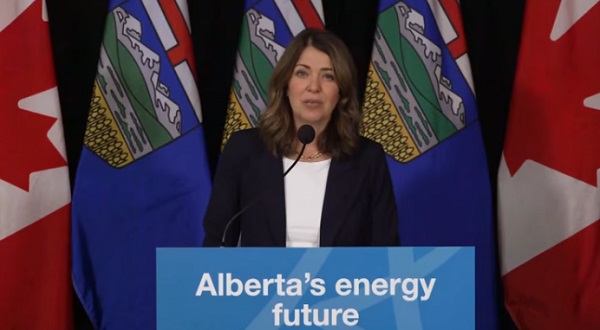Alberta
Carney forces Alberta to pay a steep price for the West Coast Pipeline MOU

From the Fraser Institute
The stiffer carbon tax will make Alberta’s oil sector more expensive and thus less competitive at a time when many analysts expect a surge in oil production. The costs of mandated carbon capture will similarly increase costs in the oilsands and make the province less cost competitive.
As we enter the final days of 2025, a “deal” has been struck between Carney government and the Alberta government over the province’s ability to produce and interprovincially transport its massive oil reserves (the world’s 4th-largest). The agreement is a step forward and likely a net positive for Alberta and its citizens. However, it’s not a second- or even third-best option, but rather a fourth-best option.
The agreement is deeply rooted in the development of a particular technology—the Pathways carbon capture, utilization and storage (CCUS) project, in exchange for relief from the counterproductive regulations and rules put in place by the Trudeau government. That relief, however, is attached to a requirement that Alberta commit to significant spending and support for Ottawa’s activist industrial policies. Also, on the critical issue of a new pipeline from Alberta to British Columbia’s coast, there are commitments but nothing approaching a guarantee.
Specifically, the agreement—or Memorandum of Understanding (MOU)—between the two parties gives Alberta exemptions from certain federal environmental laws and offers the prospect of a potential pathway to a new oil pipeline to the B.C. coast. The federal cap on greenhouse gas (GHG) emissions from the oil and gas sector will not be instituted; Alberta will be exempt from the federal “Clean Electricity Regulations”; a path to a million-barrel-per day pipeline to the BC coast for export to Asia will be facilitated and established as a priority of both governments, and the B.C. tanker ban may be adjusted to allow for limited oil transportation. Alberta’s energy sector will also likely gain some relief from the “greenwashing” speech controls emplaced by the Trudeau government.
In exchange, Alberta has agreed to implement a stricter (higher) industrial carbon-pricing regime; contribute to new infrastructure for electricity transmission to both B.C. and Saskatchewan; support through tax measures the building of a massive “sovereign” data centre; significantly increase collaboration and profit-sharing with Alberta’s Indigenous peoples; and support the massive multibillion-dollar Pathways project. Underpinning the entire MOU is an explicit agreement by Alberta with the federal government’s “net-zero 2050” GHG emissions agenda.
The MOU is probably good for Alberta and Canada’s oil industry. However, Alberta’s oil sector will be required to go to significantly greater—and much more expensive—lengths than it has in the past to meet the MOU’s conditions so Ottawa supports a west coast pipeline.
The stiffer carbon tax will make Alberta’s oil sector more expensive and thus less competitive at a time when many analysts expect a surge in oil production. The costs of mandated carbon capture will similarly increase costs in the oilsands and make the province less cost competitive. There’s additional complexity with respect to carbon capture since it’s very feasibility at the scale and time-frame stipulated in the MOU is questionable, as the historical experience with carbon capture, utilization and storage for storing GHG gases sustainably has not been promising.
These additional costs and requirements are why the agreement is the not the best possible solution. The ideal would have been for the federal government to genuinely review existing laws and regulations on a cost-benefit basis to help achieve its goal to become an “energy superpower.” If that had been done, the government would have eliminated a host of Trudeau-era regulations and laws, or at least massively overhauled them.
Instead, the Carney government, and now with the Alberta government, has chosen workarounds and special exemptions to the laws and regulations that still apply to everyone else.
Again, it’s very likely the MOU will benefit Alberta and the rest of the country economically. It’s no panacea, however, and will leave Alberta’s oil sector (and Alberta energy consumers) on the hook to pay more for the right to move its export products across Canada to reach other non-U.S. markets. It also forces Alberta to align itself with Ottawa’s activist industrial policy—picking winning and losing technologies in the oil-production marketplace, and cementing them in place for decades. A very mixed bag indeed.
Alberta
West Coast Pipeline MOU: A good first step, but project dead on arrival without Eby’s assent

The memorandum of understanding just signed by Prime Minister Mark Carney and Premier Danielle Smith shows that Ottawa is open to new pipelines, but these are unlikely to come to fruition without British Columbia Premier David Eby’s sign-off, warns the MEI.
“This marks a clear change to Ottawa’s long-standing hostility to pipelines, and is a significant step for Canadian energy,” says Gabriel Giguère, senior policy analyst at the MEI. “However, Premier Eby seems adamant that he’ll reject any such project, so unless he decides not to use his veto, a new pipeline will remain a pipedream.”
The memorandum of understanding paves the way for new pipeline projects to the West Coast of British Columbia. The agreement lays out the conditions under which such a pipeline could be deemed of national interest and thereby, under Bill C-5, circumvent the traditional federal assessment process.
Adjustments to the tanker ban will also be made in the event of such a project, but solely for the area around the pipeline.
The federal government has also agreed to replace the oil and gas emissions cap with a higher provincial industrial carbon tax, effective next spring.
Along with Premier Eby, several First Nations groups have repeatedly said they would reject any pipeline crossing through to the province’s coast.
Mr. Giguère points out that a broader issue remains unaddressed: investors continue to view Canada as a high-risk environment due to federal policies such as the Impact Assessment Act.
“Even if the regulatory conditions improve for one project, what is Ottawa doing about the long-term uncertainty that is plaguing future projects in most sectors?” asks the researcher. “This does not address the underlying reason Carney has to fast-track projects piecemeal in the first place.”
Last July, the MEI released a publication on how impact assessments should be fair, transparent, and swift for all projects, not just the few favoured by Ottawa under Bill C-5.
As of July, 20 projects were undergoing impact assessment review, with 12 in the second phase, five in the first phase, and three being assessed under BC’s substitution agreement. Not a single project is in the final stages of assessment.
In an Economic Note published this morning, the MEI highlights the importance of the North American energy market for Canada, with over $200 billion moving between Canada and the United States every year.
Total contributions to government coffers from the industry are substantial, with tens of billions of dollars collected in 2024-2025, including close to C$22 billion by Alberta alone.
“While it’s refreshing to see Ottawa and Alberta work collaboratively in supporting Canada’s energy sector, we need to be thinking long-term,” says Giguère. “Whether by political obstruction or regulatory drag, Canadians know that blocking investment in the oilpatch blocks investment in our shared prosperity.”
* * *
The MEI is an independent public policy think tank with offices in Montreal, Ottawa, and Calgary. Through its publications, media appearances, and advisory services to policymakers, the MEI stimulates public policy debate and reforms based on sound economics and entrepreneurship.
Alberta
Alberta and Ottawa ink landmark energy agreement

The Governments of Canada and Alberta have signed a new agreement to more than double oil exports to Asian markets, address investment uncertainty and reduce emissions.
This new energy partnership is a critical step towards achieving Alberta’s and Canada’s shared goal of turning our country into a world energy superpower and building a stronger and more vibrant economy.
The new energy agreement includes:
- A declaration by the federal government that an Indigenous co-owned Alberta bitumen pipeline to Asian markets is a project of national interest.
- Agreement that the parties will work together to facilitate the application, approval and construction of a privately financed and constructed 1 million+ barrel per day, Indigenous co-owned bitumen pipeline to Asian markets through a strategic deep-water port.
- Commitment by the federal government that it will not be implementing the federal oil and gas emissions cap.
- An immediate suspension of the federal Clean Electricity Regulations, and agreement the parties will work towards the construction of thousands of megawatts of AI computing power, with a large portion dedicated to sovereign computing for Canada and its allies.
- Commitment by both governments to partner with the Pathways companies to finance and construct the world’s largest carbon capture utilization and storage (CCUS) project for the purpose of making Alberta bitumen amongst the lowest emission intensity barrel of heavy oil in the world.
- In order to achieve net zero greenhouse gas emissions by 2050, the Alberta and federal governments will design and commit to globally competitive, long-term carbon pricing and sector-specific stringency factors by Apr. 1, 2026, for large Alberta emitters in both the oil and gas and electricity sectors through Alberta’s TIER system.
- Entering into a methane equivalency agreement by Apr. 1, 2026, with a 2035 target date and a 75 per cent reduction target relative to 2014 methane emissions levels.
- Agreement to immediately consult and work with Indigenous partners and the Government of British Columbia to ensure their peoples enjoy substantial economic and financial benefit from the pipeline.
- Significantly decrease regulatory uncertainty through a variety of changes to various legislation, regulation and policy.
The new agreement also demonstrates that both Alberta and Canada are focused on ways to increase the production and export of Alberta oil and gas, maximize growth in AI datacentre and related industries in Alberta, assist Canada in achieving its national security goals, create hundreds of thousands of new jobs, all while reducing the emissions intensity of Canadian oil, gas and electricity through the development and implementation of CCUS, nuclear and other emissions reducing technologies.
“This is Alberta’s moment of opportunity to take the first steps toward being a global energy superpower and show the nation that resource development and sustainability can coexist. There is much hard work ahead of us, but today is a new starting point for nation building as we increase our energy production for the benefit of millions and forge a new relationship between Alberta and the federal government.”
Oil pipeline
An Indigenous co-owned bitumen pipeline to Asian markets will ensure the province and country are no longer dependent on just one customer to buy their most valuable resource. It is agreed this new pipeline would be in addition to the expansion of the Trans Mountain pipeline for an additional 300,000 to 400,000 barrels per day destined for Asian markets.
This agreement also allows for needed adjustments to the tanker ban when the new pipeline to Asia is approved by the major projects office, as well as amendments that ensure Alberta’s energy companies can advertise their environmental leadership and efforts throughout the world without fear of penalty.
“This pipeline is an excellent opportunity to demonstrate partnership and progress. My hope is that it will create lasting economic benefits for First Nations and strengthen the relationships that matter most — government-to-government and community-to-community. Indigenous equity ownership is shaping Canada’s economy, and when our voices help guide every decision, we build trust and a future that will support generations to come.”
Oil and gas emissions cap
The federal government has also committed to not implementing the oil and gas emissions cap, allowing for a massive increase in oil production and private sector jobs and moving Alberta towards its goal of reaching six million barrels per day of oil production by 2030 and eight million barrels per day by 2035.
“The Energy Accord signed today by Prime Minister Carney and Premier Smith sends an important signal that Canada’s oil and gas development is integral to the economy and is open for business. This agreement shows that Canada is taking action to address regulations and policy that are impacting competitiveness and investment.”
“The Business Council of Alberta is delighted to see the removal of the oil and gas emissions cap, which was a cap on production and prosperity in Canada. Now, without the cap, Canada truly can grow energy production, export globally, and generate the investments and jobs that will help deliver a better quality of life for all Canadians.”
Clean Electricity Regulations
The agreement also includes the immediate suspension of the Clean Electricity Regulations in Alberta, which will stabilize Alberta’s power grid and enable massive investments in AI data centres in the province. Instead, Alberta will work with the federal government and industry on a new industrial carbon pricing agreement, to be administered through Alberta’s TIER program.
Pathways and emissions reduction
Both governments are committed to working together with the Pathways companies to advance the completion of the world’s largest CCUS infrastructure project.
This will make Alberta a world leader in the development and implementation of emissions reduction infrastructure – particularly in carbon capture utilization and storage. Alberta bitumen will be the cleanest heavy oil on the planet displacing heavier emitting oil from Russia, Venezuela and Iran, and bringing better environmental and geopolitical outcomes.
“The Pathways Alliance appreciates the leadership of both Prime Minister Carney and Premier Smith in entering this important Memorandum of Understanding which supports the growth of an industry that is critical to Canada’s economy. We look forward to working on the details with both the federal and Alberta governments in the coming months with our shared goal of Canada being an energy superpower.”
-

 Business1 day ago
Business1 day agoBlacked-Out Democracy: The Stellantis Deal Ottawa Won’t Show Its Own MPs
-

 Agriculture1 day ago
Agriculture1 day agoHealth Canada pauses plan to sell unlabeled cloned meat
-

 Alberta2 days ago
Alberta2 days agoPremier Danielle Smith says attacks on Alberta’s pro-family laws ‘show we’ve succeeded in a lot of ways’
-

 Artificial Intelligence2 days ago
Artificial Intelligence2 days agoGoogle denies scanning users’ email and attachments with its AI software
-

 Alberta2 days ago
Alberta2 days agoNew pipeline from Alberta would benefit all Canadians—despite claims from B.C. premier
-

 Crime24 hours ago
Crime24 hours agoB.C.’s First Money-Laundering Sentence in a Decade Exposes Gaps in Global Hub for Chinese Drug Cash
-

 COVID-192 days ago
COVID-192 days agoCrown seeks to punish peaceful protestor Chris Barber by confiscating his family work truck “Big Red”
-

 International1 day ago
International1 day agoAmerica first at the national parks: Trump hits Canadians and other foreign visitors with $100 fee








